 Craster kippers served with buns | |
| Type | Kipper |
|---|---|
| Place of origin | United Kingdom |
| Region or state | Craster |
Craster kippers are kippers from the Northumberland fishing village of Craster. They have been acclaimed as the best British kipper. [1]
 Craster kippers served with buns | |
| Type | Kipper |
|---|---|
| Place of origin | United Kingdom |
| Region or state | Craster |
Craster kippers are kippers from the Northumberland fishing village of Craster. They have been acclaimed as the best British kipper. [1]
Like the Newmarket sausage or the Stornoway black pudding, the Craster kipper is a British food named after, and strongly associated with, its place of origin. Although the herrings used for Craster kippers may no longer be strictly local, [2] the defining characteristic of the Craster kipper is that the smoking process takes place in a smokehouse located in or around the village of Craster.
Clarissa Dickson Wright has named Craster as the birthplace of the kipper. [3] There is, however, some dispute over this – other places, including the nearby town of Seahouses, also claim this distinction.[ citation needed ]
Although a long-standing tradition in Craster, commercial kipper production is currently only continued there by L. Robson & Sons, using their over 100-year-old smokehouses. [4]
The preparation process begins with selected raw North Sea herring, known locally as "silver darlings". [5] These are split, gutted and washed, [6] soaked in brine, and then taken to the smokehouse where they are cured over smouldering oak and white wood shavings for sixteen hours. [7] The famous smokehouse is unmistakable — a stone building often with white plumes pouring out of the wooden vents in the roof. [8]
In appearance a Craster kipper is still recognizably a fish; the head is preserved and, unlike some other kippers which are dyed using annatto, the natural colours of the Craster kipper's skin are tanned golden by the oak smoke. [9] The flesh has a distinctive reddish-brown colour. [10]
It has been said that comparing the Craster kipper with a common commercial processed kipper is like "comparing a fillet steak with a cheap burger", [9] and that "on the tongue, the [Craster] kipper is as delicate, as sophisticated, as the finest smoked salmon in the world and costs but a fraction of the price." [11]
Craster kippers have been described as "the best", [1] although that claim has also been made of other British kippers such as Loch Fyne kippers. [12]

A kipper is a whole herring, a small, oily fish, that has been split in a butterfly fashion from tail to head along the dorsal ridge, gutted, salted or pickled, and cold-smoked over smouldering wood chips.
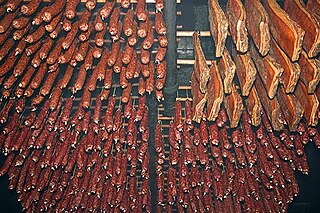
Smoking is the process of flavoring, browning, cooking, or preserving food, particularly meat, fish and tea, by exposing it to smoke from burning or smoldering material, most often wood.

Northumberland is a ceremonial county in North East England, bordering Scotland. It is bordered by the Scottish Borders to the north, the North Sea to the east, Tyne and Wear and County Durham to the south, and Cumbria to the west. The town of Blyth is the largest settlement. Northumberland is the northernmost county in England.

Craster is a small fishing village on the Northumberland coast of England, eight miles (13 km) from Alnwick. The next village to the north is Embleton. It is within the Northumberland Coast Area of Outstanding Natural Beauty.

Seahouses is a large village on the North Northumberland coast in England. It is about 20 kilometres (12 mi) north of Alnwick, within the Northumberland Coast Area of Outstanding Natural Beauty.
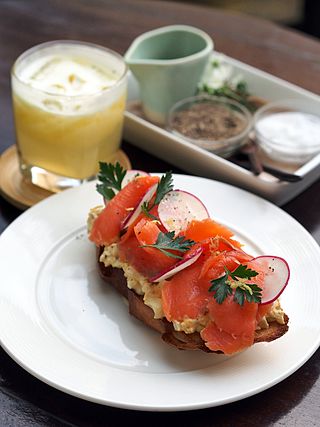
Smoked salmon is a preparation of salmon, typically a fillet that has been cured and hot or cold smoked.
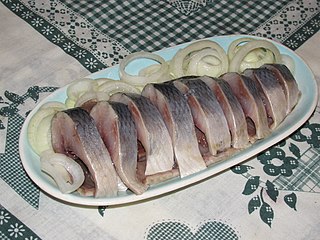
Pickled herring is a traditional way of preserving herring as food by pickling or curing.

Clarissa Theresa Philomena Aileen Mary Josephine Agnes Elsie Trilby Louise Esmerelda Johnston Dickson Wright was an English celebrity cook, television personality, writer, businesswoman, and former barrister. She was best known as one of the Two Fat Ladies, with Jennifer Paterson, in the television cooking programme from 1996 to 1999. She was an accredited cricket umpire and one of only two women to become a Guild Butcher.

Beadnell is a village and civil parish in Northumberland, England. It is situated about 4 miles (6.4 km) south-east of Bamburgh, on the North Sea coast, and has a population of 528(2001), increasing to 545 at the 2011 Census. It takes its name from the Anglo Saxon "Bede's Hall". The earliest written reference is found in 1161.

Smoked fish is fish that has been cured by smoking. Foods have been smoked by humans throughout history. Originally this was done as a preservative. In more recent times fish is readily preserved by refrigeration and freezing and the smoking of fish is generally done for the unique taste and flavour imparted by the smoking process.

Cured fish is fish which has been cured by subjecting it to fermentation, pickling, smoking, or some combination of these before it is eaten. These food preservation processes can include adding salt, nitrates, nitrite or sugar, can involve smoking and flavoring the fish, and may include cooking it. The earliest form of curing fish was dehydration. Other methods, such as smoking fish or salt-curing also go back for thousands of years. The term "cure" is derived from the Latin curare, meaning to take care of. It was first recorded in reference to fish in 1743.

The food of the Tlingit people, an indigenous group of people from Alaska, British Columbia, and the Yukon, is a central part of Tlingit culture, and the land is an abundant provider. A saying amongst the Tlingit is that "When the tide goes out the table is set." This refers to the richness of intertidal life found on the beaches of Southeast Alaska, most of which can be harvested for food. Another saying is that "in Lingít Aaní you have to be an idiot to starve". Since food is so easy to gather from the beaches, a person who cannot feed himself at least enough to stay alive is considered a fool, perhaps mentally incompetent or suffering from very bad luck. Though eating off the beach could provide a fairly healthy and varied diet, eating nothing but "beach food" is considered contemptible among the Tlingit, and a sign of poverty. Shamans and their families were required to abstain from all food gathered from the beach, and men might avoid eating beach food before battles or strenuous activities in the belief that it would weaken them spiritually and perhaps physically as well. Thus for both spiritual reasons as well as to add some variety to the diet, the Tlingit harvest many other resources for food besides what they easily find outside their front doors. No other food resource receives as much emphasis as salmon; however, seal and game are both close seconds.

Bokkoms is whole, salted and dried mullet, and is a well-known delicacy from the West Coast region of South Africa. This salted fish is dried in the sun and wind and is eaten after peeling off the skin. In some cases it is also smoked. It is sometimes referred to as "fish biltong".
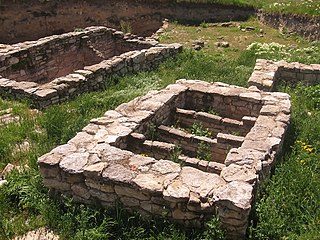
Fish preservation is the method of increasing the shelf life of fish and other fish products by applying the principles of different branches of science in order to keep the fish, after it has landed, in a condition wholesome and fit for human consumption. Ancient methods of preserving fish included drying, salting, pickling and smoking. All of these techniques are still used today but the more modern techniques of freezing and canning have taken on a large importance.

A smokehouse or smokery (British) is a building where meat or fish is cured with smoke. The finished product might be stored in the building, sometimes for a year or more. Even when smoke is not used, such a building—typically a subsidiary building—is sometimes referred to as a "smokehouse". When smoke is not used, the term meathouse or meat house is common.
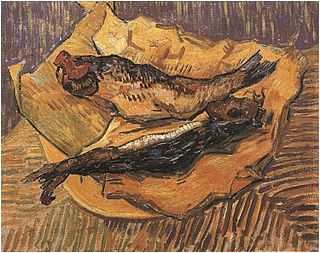
Bloaters are a type of whole cold-smoked herring. Bloaters are "salted and lightly smoked without gutting, giving a characteristic slightly gamey flavour" and are particularly associated with Great Yarmouth, England. Popular in the 19th and early 20th centuries, the food is now described as rare. Bloaters are sometimes called a Yarmouth bloater, although production of the product in Yarmouth appears to have now ceased in the town with the closure of its smoked fish factory in 2018. The bloater is also sometimes jokingly referred to as a Yarmouth capon, two-eyed steak, or Billingsgate pheasant.

Herring are forage fish in the wild, mostly belonging to the family Clupeidae. They are an important food for humans. Herring often move in large schools around fishing banks and near the coast. The most abundant and commercially important species belong to the genus Clupea, found particularly in shallow, temperate waters of the North Pacific and North Atlantic Oceans, including the Baltic Sea, as well as off the west coast of South America. Three species of Clupea are recognized; the main taxon, the Atlantic herring, accounts for over half the world's commercial capture of herrings.
Craster oak-smoked kippers are famous, but the fresh fish is brought in from elsewhere
If you go up the coast further you will come to Craster, the birthplace of the kipper